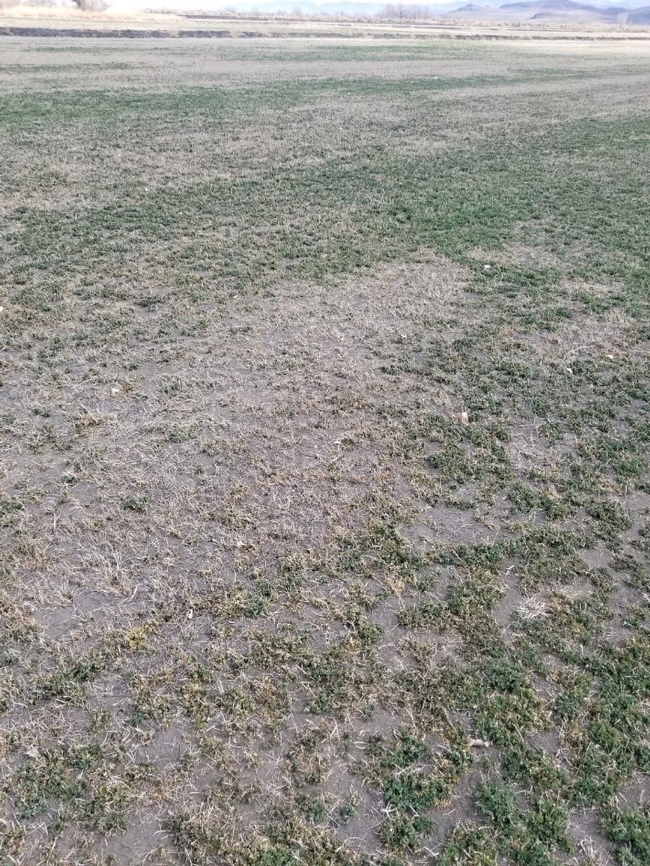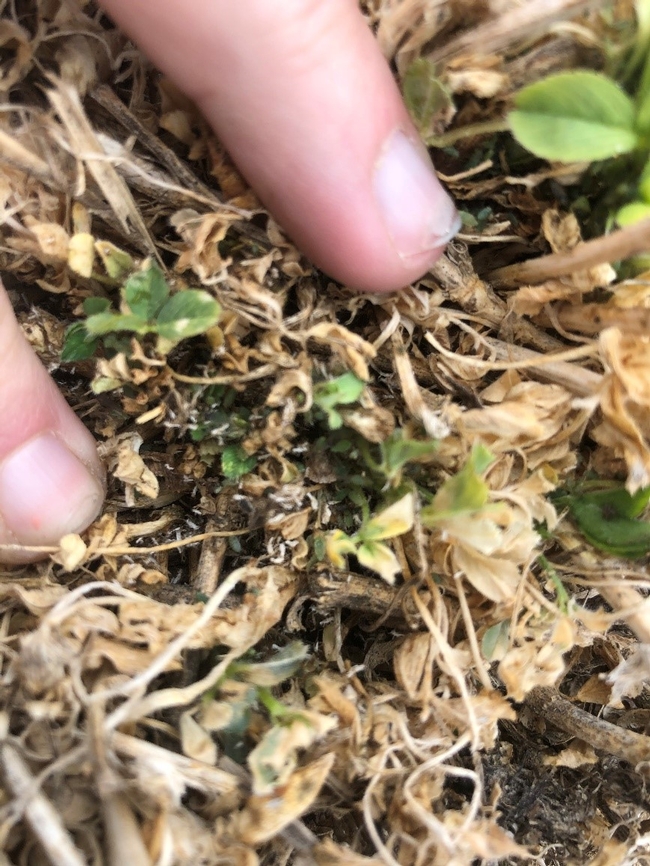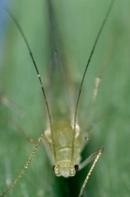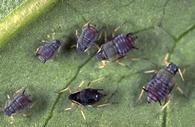The California Department of Pesticide Regulation is currently reviewing the use of Transform (sulfoxaflor) for insect pest management in alfalfa hay production. A decision on whether to register Transform with a label for use in California alfalfa is expected to occur by the end of 2020. The registration of Transform has been so far deferred due to concerns of potential impacts on pollinators. Transform currently has a full EPA label for use in alfalfa hay in all other states, but not in California.
This is something California alfalfa growers and PCAs should pay attention to, and consider weighing in.
Figure 1. Blue Alfalfa Aphid Damage, Nevada, 2020. Growers in other states are able to use Transform to control this damaging pest.
Why is this of interest? California, with its mild climate, supports a wide range of sucking insects, including an array of alfalfa pests including blue alfalfa aphid (BAA), pea aphid (PA), spotted alfalfa aphid (SAA), cowpea aphid (CPA), as well as whitefly and leafhoppers.
Figure 2. Blue alfalfa aphid (left) and Cowpea aphid (right) are commonly seen in alfalfa fields. The blue aphid is particularly difficult to control.
There have been major insect pest outbreaks in alfalfa in recent years (see article “The Blue Alfalfa Aphid: A continuing problem” ). Growers have struggled to control these devastating pests, unfortunately often spraying multiple times with broad-spectrum insecticides in attempts to control their damage. The BAA especially has become more difficult to control.
This is a problem for several reasons: 1) These hard-to-control infestations have been economically devastating to California growers, 2) growers often use broad-spectrum insecticides which have the unfortunate effect of damaging beneficial predator populations (which help to control remaining pests) – see ‘Natural Enemies are Important”, and 3) over-use of the same insecticides can lead to insecticide resistance (see blog). These lead to environmental problems (excessive pesticide use), insecticide resistance, as well as high costs and low production.
Diverse Tools Needed. Targeted and effective, aphid-specific tools for alfalfa are critically needed by this industry, which is losing insecticides (e.g. see ‘The End of Chlorpyrifos') and has seen pests become increasingly difficult to control. Transform would be a useful tool to address this need.
Our data suggest that Transform works well for managing serious sucking insects like aphids, whiteflies, and leafhoppers that cause significant yield and quality losses in alfalfa. BAA continues to be challenging to control with significant yield and quality losses occurring statewide (See Blog ‘I'll be Back' from April, 2020). Stubble fields that are just breaking dormancy late winter are the most at risk of stand and yield losses. Small, growing plants are vulnerable to the toxins that BAA inject during feeding.
Statewide Label Needed. Transform currently has a Section 24c Special Local Needs (SLN) in California for Siskiyou, Lassen, Modoc, and Shasta Counties for helping to manage BAA and other aphid pests, with restrictions (applications must occur between 7pm and 7am OR when the temperature is below 50 F at the site of application).
Alfalfa growers would greatly benefit from a statewide label for Transform in alfalfa, similar to what is in place in other states, especially for southern regions which have seen devastating aphid infestations. Transform would be a good tool to have in alfalfa because UC Cooperative Extension (UCCE) research has shown that:
1) UCCE trials in the low desert suggest that Transform may have better efficacy controlling BAA in this area than Sivanto (flupyradifurone), another aphicide registered for use in alfalfa.
2) Transform is softer on beneficial insects than currently registered pyrethroids, organophosphates, and carbamate insecticides, helping to prevent secondary pest outbreaks and resurgence of pests.
3) Transform provides growers with a much-needed tool to control multiple pests during a single growing season, including whiteflies, aphids, and leafhoppers, which unfortunately may take multiple insecticide applications otherwise.
Restrictions. CA-DPR also needs to address the restrictions in the current 24c SLN because they are problematic for several reasons:
1) UCCE research shows that night time or early morning dew on the alfalfa foliage may interfere with the efficacy of Transform, resulting in a 30% reduction in efficacy. This is important since yield damage can occur from blue alfalfa in just a few days.
2) For warmer regions of the Central Valley and the Low Desert regions (Palo Verde and Imperial Valley), restricting applications to < 50oF is nearly impossible to meet because BAA is most problematic in March when temperatures are often above this.
3) Keep in mind that forage alfalfa harvested in spring (when aphids are most damaging) is largely harvested in the bud stage, not flowering, lessening the risk to pollinators, especially given a 7-day pre-harvest interval, which is typically well before flowering.
4) Night-time applications are more dangerous for applicators. Worker health and safety is improved for daytime applications.
Summary
A full label for Transform would be of benefit to farmers and would help reduce the over-use of broad spectrum insecticides that we have observed taking place in attempts to control large aphid infestations. We have observed farmers unfortunately spraying multiple times (e.g. a pesticide treadmill), when a more focused aphid control measure would be more effective, and protect beneficial insects. UCCE research has shown that Transform provides excellent control of piercing-sucking insects like aphids, whiteflies, and leafhoppers, and would contribute to a diversity of tools to manage insect pests in an integrated way. Transform (sulfoxaflor) is a selective insecticide that is relatively safe for important aphid predators such as lady beetles and lacewings and thus contributes to goals of IPM.



